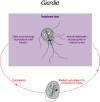Parasite zoonoses and wildlife: emerging issues
- PMID: 19440409
- PMCID: PMC2672361
- DOI: 10.3390/ijerph6020678
Parasite zoonoses and wildlife: emerging issues
Abstract
The role of wildlife as important sources, reservoirs and amplifiers of emerging human and domestic livestock pathogens, in addition to well recognized zoonoses of public health significance, has gained considerable attention in recent years. However, there has been little attention given to the transmission and impacts of pathogens of human origin, particularly protozoan, helminth and arthropod parasites, on wildlife. Substantial advances in molecular technologies are greatly improving our ability to follow parasite flow among host species and populations and revealing valuable insights about the interactions between cycles of transmission. Here we present several case studies of parasite emergence, or risk of emergence, in wildlife, as a result of contact with humans or anthropogenic activities. For some of these parasites, there is growing evidence of the serious consequences of infection on wildlife survival, whereas for others, there is a paucity of information about their impact.
Keywords: Echinococcus; Giardia; Leishmania; Sarcoptes; Toxoplasma; Trypanosoma; Wildlife; biosecurity; emergence; parasitic infections; zoonoses.
Figures






References
-
- Daszak P, Cunningham AA, Hyatt AD. Emerging infectious diseases of wildlife – threats to biodiversity and human health. Science. 2000;287:443–449. - PubMed
-
- Holmes JC. Parasites as threats to biodiversity in shrinking ecosystems. Biodivers. Conservn. 1996;5:975–983.
-
- McCallum H, Dobson A. Detecting disease and parasite threats to endangered species and ecosystems. Trends Ecol. Evol. 1995;10:190–194. - PubMed
-
- Maillard J-C, Gonzalez J-P. Biodiversity and emerging disease. Ann. N.Y. Acad. Sci. 2006;1081:1–16. - PubMed
Publication types
MeSH terms
LinkOut - more resources
Full Text Sources
Medical

